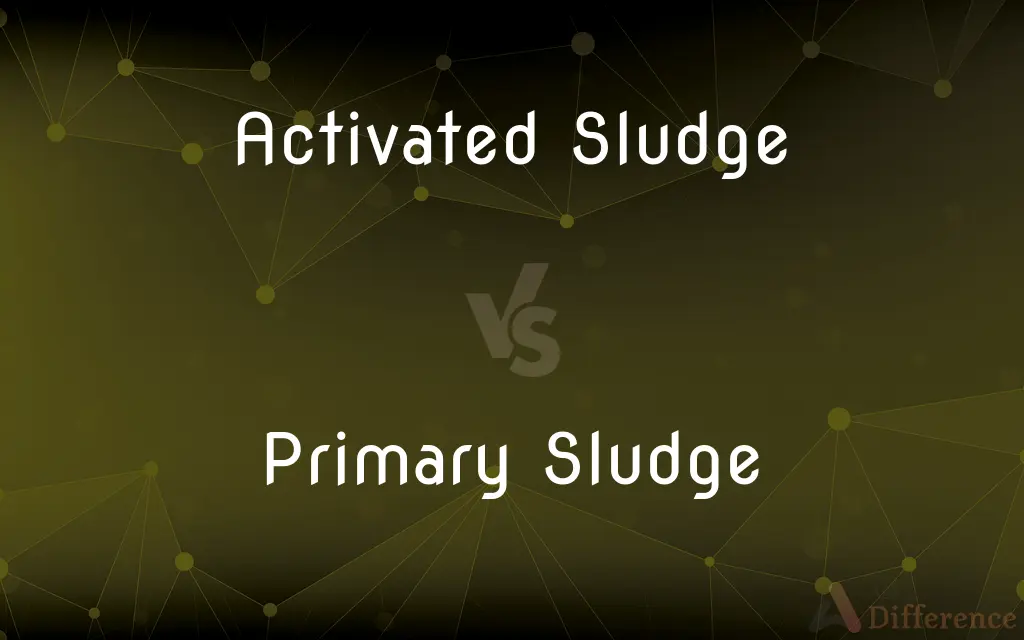Activated Sludge vs. Primary Sludge — What's the Difference?
By Tayyaba Rehman — Published on November 11, 2023
Activated Sludge is a Microorganism-rich sludge used to digest pollutants. Primary Sludge is Solid waste settled from raw wastewater during primary treatment.

Difference Between Activated Sludge and Primary Sludge
Table of Contents
ADVERTISEMENT
Key Differences
Activated Sludge is a component in wastewater treatment processes that involves a concentrated suspension of bacteria and other microorganisms. It plays a crucial role in the secondary stage of treatment, digesting organic matter within the wastewater. On the other hand, Primary Sludge refers to the solid material that is physically settled out from the wastewater during the primary treatment stage, which involves the physical processes of sedimentation or floating.
Activated Sludge operates on the principle of utilizing aerobic biological treatment processes, wherein the microorganisms break down the organic pollutants and convert them into simpler compounds, aiding in the overall purification of the wastewater. Conversely, Primary Sludge is the direct product of physical sedimentation of solid particles and does not involve biological processes in its formation, mainly accumulating heavy particulates and settable solids from the wastewater.
In the case of Activated Sludge, it is generated from the secondary treatment, where microorganisms are actively utilized to degrade the organic pollution, and it must be managed carefully to maintain a healthy microbial community. In contrast, Primary Sludge originates directly from the primary treatment, before any biological treatment has been applied, comprising mostly of raw organic and inorganic materials extracted from the wastewater through gravitational settling.
Activated Sludge requires aeration tanks where the wastewater is mixed with microorganisms under aerated conditions to facilitate the breakdown of pollutants. The concept here revolves around keeping the microorganisms active and efficient. In comparison, Primary Sludge is obtained through sedimentation tanks where the flow speed of the wastewater is slowed down, allowing the solids to settle at the bottom, and are then removed mechanically without involving biological entities.
Activated Sludge systems demand more energy and operational input due to the aeration processes, and the management of the biological flocs to assure efficient pollution removal from the wastewater. In distinction, Primary Sludge creation is relatively straightforward, involving less energy, primarily relying on gravitational forces to settle out the solids and does not employ microorganisms for treatment at this stage.
ADVERTISEMENT
Comparison Chart
Process Stage
Secondary treatment involving biological processes
Primary treatment involving physical processes
Main Components
Microorganisms
Settled solid waste
Energy Use
High (due to aeration and circulation)
Low
Pollutant Removal
Biological degradation of organic pollutants
Physical settling of solids
Management
Requires maintaining healthy microbial communities
Relatively straightforward management
Compare with Definitions
Activated Sludge
A biologically active sediment used in secondary wastewater treatment.
The activated sludge was aerated to enhance microbial activity.
Primary Sludge
Material settled from sewage before biological treatment processes.
A significant volume of primary sludge is often found in sedimentation tanks.
Activated Sludge
Concentrated suspension of bacteria employed in wastewater management.
The treatment plant expanded its capacity to handle more activated sludge.
Primary Sludge
The initial precipitate derived from physical processes in wastewater treatment.
The treatment facility designed new methods for managing primary sludge.
Activated Sludge
Sludge that contains microbes to digest organic materials in wastewater.
Managing activated sludge is essential for the optimal functioning of the treatment plant.
Primary Sludge
Solid waste extracted from wastewater during primary treatment.
The primary sludge was removed to proceed to secondary wastewater treatment.
Activated Sludge
Biological flocs that aid in the decomposition of organic waste in sewage.
Efficient breakdown of pollutants is dependent on the effective use of activated sludge.
Primary Sludge
The first solid residue obtained through gravitational settling in wastewater management.
Primary sludge is typically thicker and denser due to the settled materials.
Activated Sludge
Microorganism-rich sludge utilized to break down pollutants in sewage.
Activated sludge systems require careful monitoring to ensure efficacy.
Primary Sludge
Settled organic and inorganic matter derived from raw sewage during treatment.
Efficient removal of primary sludge is crucial for subsequent wastewater processing stages.
Common Curiosities
What materials predominantly compose Primary Sludge?
Primary Sludge is composed of settled organic and inorganic solids from wastewater.
How is Primary Sludge formed?
Primary Sludge forms by settling solids during the primary wastewater treatment stage.
What is the main role of Activated Sludge?
Activated Sludge breaks down organic pollutants in wastewater using microorganisms.
Does Activated Sludge require aeration?
Yes, Activated Sludge requires aeration to maintain microbial activity.
Are specific bacteria essential for Activated Sludge?
Yes, specific bacteria are essential to breakdown particular pollutants in Activated Sludge.
Is Primary Sludge produced before Activated Sludge in treatment?
Yes, Primary Sludge is produced during the initial phase of wastewater treatment.
Can Activated Sludge be used to treat industrial wastewater?
Yes, Activated Sludge can treat industrial wastewater depending on the pollutant type.
What happens to Primary Sludge after it is removed?
Primary Sludge can be further treated, used, or disposed of following environmental guidelines.
How does Activated Sludge affect pollutant levels?
Activated Sludge reduces pollutant levels by biologically degrading them.
What parameters are crucial for maintaining healthy Activated Sludge?
Parameters like pH, temperature, and aeration are vital for maintaining healthy Activated Sludge.
How is Primary Sludge typically removed from wastewater?
Primary Sludge is usually removed through gravitational settling and mechanical extraction.
What happens if Activated Sludge is not properly managed?
Improper management of Activated Sludge can lead to reduced treatment efficiency and operational issues.
Can Primary Sludge be utilized for anything after removal?
Yes, after further treatment, Primary Sludge can be used in applications like fertilizer production.
Is the disposal of Primary Sludge regulated?
Yes, the disposal of Primary Sludge is regulated to prevent environmental damage.
What is the significance of the F/M ratio in Activated Sludge?
The F/M (Food to Microorganism) ratio is crucial for balancing nutrient availability and microbial growth in Activated Sludge.
Share Your Discovery

Previous Comparison
Red Antifreeze vs. Green Antifreeze
Next Comparison
Asset Backed Securities vs. Mortgage Backed SecuritiesAuthor Spotlight
Written by
Tayyaba RehmanTayyaba Rehman is a distinguished writer, currently serving as a primary contributor to askdifference.com. As a researcher in semantics and etymology, Tayyaba's passion for the complexity of languages and their distinctions has found a perfect home on the platform. Tayyaba delves into the intricacies of language, distinguishing between commonly confused words and phrases, thereby providing clarity for readers worldwide.












































